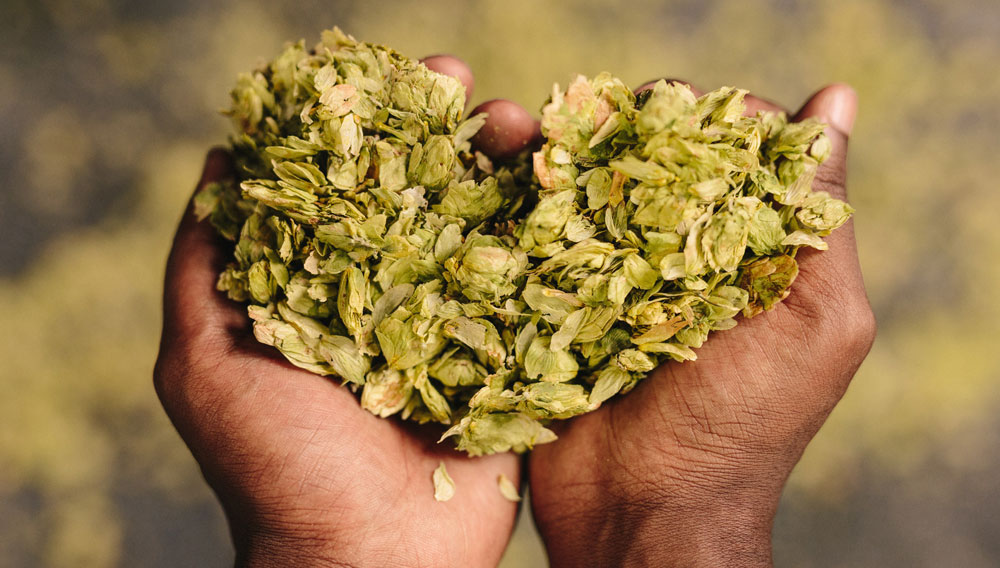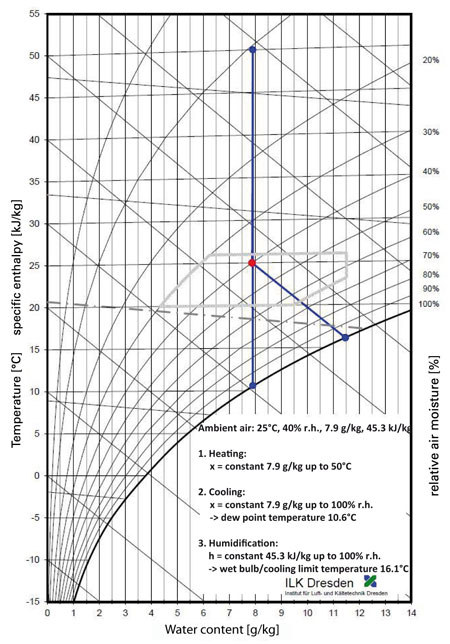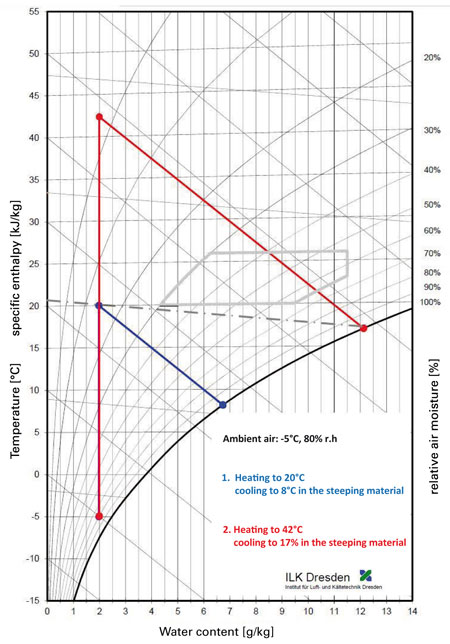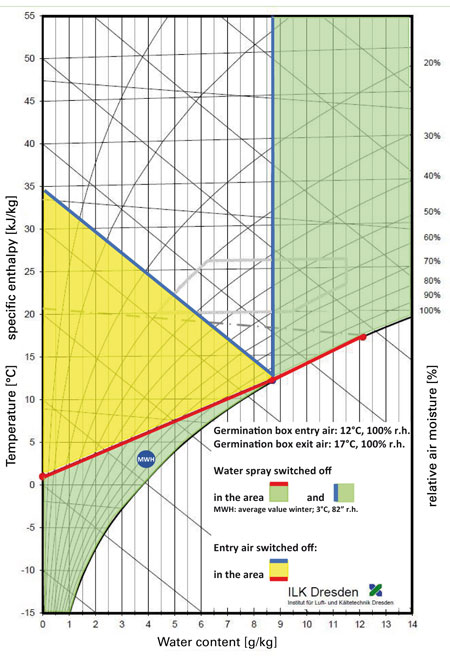Optimisation potential for maltings is in the air
Mollier diagram | Energy input in the form of electricity and heat represents the major cost factor in the malting process – roughly 40 % of total production costs and more than 60 % of variable costs. It comes as no surprise that the malting industry has successfully focused on the issue of energy for decades and that saving potentials are largely exhausted. When further optimisation potentials will have been identified, it will be necessary to have a highly developed technological and technical understanding and a love for details.
Malting is not possible without air. It is the indispensable assistant of maltsters, it introduces oxygen into the germinating material and removes carbon dioxide, it humidifies and dries the germinating material and provides it with heat and dissipates same. Up to 90 % of all energy costs are accounted for by process air that is used for circulation, heating and cooling. It would thus be interesting to have a closer look at air processes. First of all, the following issue has to be addressed: how is it possible at all to characterise the state of air?
Everybody is familiar with air temperature in degree Celsius as a parameter; it can be measured easily, exactly and everywhere. Relative air humidity in % is another important parameter; this indicates the amount of water vapour contained in the air at a specific temperature in relation to the maximum possible vapour content, referred to as saturation. Simple and reliable measurement systems also exist for standard ambient conditions. Measurement becomes problematic at numerous, interesting points in the process air for maltings in view of the existing states in terms of moisture, temperature and corrosive and microbial attacks, unfavourable for sensory analysis. It will be explained later that relative humidity can be measured very easily indirectly using the Mollier diagram.
The pressure of air
Pressure is another very important parameter that is frequently not taken into account in maltings and is significant for characterising air. The prevailing atmospheric pressure at the particular location of the operation has an influence on plant sizing in view of the geographic altitude of the malting. The higher the elevation of the plant, the more unfavourable will be the relationship between mass flow and volume flow and thus between defined determining parameters and transport energy for process air due to decreasing air density. An extreme example is a malting in Bogota, Colombia, located at an elevation of 2600 m above sea level: normal atmospheric pressure 725 hPa or 72 % of “our” 1013 hPa and correspondingly lower air density.
Apart from these parameters specified in relation to location, pressure build-up for overcoming air resistances of fans has a major influence on power consumption. In many plants, operating pressure is usually recorded only under the kiln floor, if at all. It takes little effort to record all points where differential pressures arise in terms of operational energy monitoring. A simple U-tube or inclined tube manometer would do the job. Deposits on filters and, above all, on heat exchangers, cooling and heating batteries which have not been removed give rise to unnecessary differential pressures and an increase of same not recognised at the point of origin. From a physical point of view and, unfortunately, also in our case, air resistances go up and, associated with this, also power consumptions rise as the square of the ratio between the rise in air velocity or a volume flow carried by a channel duct.
Based on this knowledge, it is necessary to attach importance – when sizing maltings and their components – to provide adequate flow profiles as well as cleanability and accessibility to heat exchangers. It is not uncommon that this is not done, due to limited investment budgets or offers by manufacturers who would like to gain a price advantage based on tight sizing. Sensible attention and an honest commitment to sustainability that is not just posted on a trade fair booth save money and protect the environment in the long term.
The Mollier diagram helps
Maltsters can use the Mollier diagram as an excellent tool for characterisation of air states and description of processes in maltings that involve air. The Mollier diagram is also dependant on atmospheric pressure and can reflect different sea levels in some instances. In our part of the world, sufficient accuracy is obtained when a Mollier diagram isobar is used for normal atmospheric pressures of 1013 hPa.
The Mollier diagram, also referred to as ix or H-S diagram, was developed by Richard Mollier (1863-1935), Professor of Physics in Dresden. It is used to determine the states of air and changes of states of moist air in a coordinate system with arrays of curves (fig. 1).
Using the example selected as starting point, a state of air of 25 °C and 40 % relative humidity, it is possible to calculate all other relevant parameters of this state of air based on these two parameters: water vapour content 7.9 g/kg, enthalpy 45.3 kJ/kg, density 1.18 kg/m3. Processes relevant to maltings are:
- Heat added to the air in a duct with a constant moisture content, in our case 7.9 g/kg, vertically upwards up to the 50 °C line, involving an increase in energy content from 45.3 kJ/kg to 71.0 kJ/kg. For the malting process, heating of the kiln air.
- Air cooling, also on a duct with a constant moisture content, vertically downwards down to the saturation line at 100 % relative air humidity; the energy content of the air drops from 45.3 kJ/kg to 30.6 kJ/kg. This intersection of the two lines describes the dew point temperature of the starting state of air, here 10.6 °C. For the malting process: cooling of air going into the germination boxes.
- Adiabatic humidification of the air on a constant enthalpy line, here 45.3 kJ/kg up to the 100 % saturation line. This intersection of the two lines describes the cooling limit temperature, also referred to as wet bulb temperature, here 16.1 °C. For the malting process: humidification of air going into the steep tanks and water removal in the kiln.
Application examples
The steeping material is too cold
It is a harsh winter. The steeping house is cold. Cool barley is soaked with cool water. Temperature does not develop in the steep tank, with negative consequences: water uptake by barley is too slow, and after transfer to the germinating box, pregermination and heat development are delayed. The preset residence time in the germination box is too short to achieve target modification. The malting rhythm is disturbed, leading to capacity and/or quality problems.
Heating the steeping house to remedy this problem is a solution often encountered. Will this achieve the desired effect? It is worthwhile to have a look at the Mollier diagram (fig. 2):
Ambient air of –5 °C and 80 % relative humidity was selected for this example. This is heated to 20 °C, e.g. with a room or tent heater, and blown into the steeping house. Workmen have a sense of well-being and pipes do not freeze. That is all that has been achieved. When heated air comes into contact with the moist cereal in the steeping tank during dry steeping, adiabatic humidification will set in until wet bulb temperature is reached, in our case 8 °C. This is too low to appreciably start a physiological germination processes. In theory, the air should be heated to above 40 °C so that the 16 °C still reach the steeping material. Even then, the volume or mass flow of the fan is insufficient for CO2 extraction to obtain the required enthalpy in the germination material. The problem can only be solved by heating the steep water to e.g. 20 °C so that, when mixing with cold barley, the latter is surrounded by a “comfortable temperature” of around 16 °C. In an ideal case, exhaust heat sources available should be used. Water-flue gas heat exchangers e.g. are available that can transfer the residual energy in the flue gas after the kiln air heater to the steep water for exactly this reason.
Conditioning of germination box entry air
During germination, it should be ensured that the germinating material does not dry out, if possible. This can be done by moistening the entry air to the germination boxes with water nozzles up until saturation so that any desiccation potential in the entry air cannot remove water unnecessarily. Care should be taken that the nozzles vaporise the water as finely as possible and make do with relatively low pressure and water quantities. Such technically proven solutions are installed e.g. in greenhouses. Nevertheless, such a system utilises water resources, produces waste water that has to be treated, uses pump energy and has to be maintained. Such humidification systems generally operate the whole year round. Is this really necessary?
However, vaporisation of water into unsaturated air results in adiabatic water uptake and cooling down to the wet bulb temperature. When this is below the desired entry temperature in the germination box, air cooling using a refrigerating plant can be dispensed with and electric power saved though the ambient air measured is in some instances significantly higher than the target temperature at the germination box entry. When deciding whether water vaporisation or the refrigerating plant should be switched on or off, a look at the Mollier diagram is helpful again.
It is assumed in the following example that the germination box entry temperature should be 12 °C at 100 % relative humidity and the exit temperature should be 17 °C, also saturated to the tune of 100 %. Three different cases are plotted in the Mollier diagram (fig. 3).
- The ambient air entering the germination box is below the target temperature. The refrigeration plant is switched off. The automatic temperature control for the entry temperature opens the return air flap and supplies warm exhaust air from the germination boxes (17 °C and 100 % r.h.) to the incoming fresh air until the target temperature (12 °C, 100 % r.h.) is reached. When the state of the ambient air is located below the red line in the green field of the Mollier diagram, the air mixture will result in a saturated air state at the germination box entry and air humidification can be switched off. The average state of air in winter in our part of the world is currently 3 °C and 82 % r.h. (blue spot) and is located in the green field.
- The ambient air is above the target temperature and has to be cooled using the refrigeration plant. When the moisture content of the ambient air is above that of the saturated entry temperature, in our case 8.7 g/kg, the cooling battery cools the ambient air down below dew point temperature and water is removed. The cooled air is saturated to the tune of 100 % and air humidification can be switched off. This area is located on the right-hand side, also in the green field, in the Mollier diagram.
- In view of the state of the ambient air, water vaporisation is required to reach a saturation of 100 % at the germination box entry. However, when its enthalpy is lower than the enthalpy of the desired air state at the germination box entry, in our case 34.2 kJ/kg, water vaporisation will again result in adiabatic moisture uptake and cooling of the air down to the wet bulb temperature that is below the target temperature. The refrigeration plant can be switched off now. These air states are located in the yellow field in the Mollier diagram.
Modification of desiccation potential
It is obvious that knowledge of the air states – measurement required! – and correct interpretation of same in the Mollier diagram can provide optimisations and savings. However, the fear that the germinating material in the germination box may dry out frequently focusses on desiccation brought about by the desiccation potential of unsaturated supply air. Even if this potential exists to a greater or lesser degree based on the above statements, desiccation will take place within only a few centimetres in the bottommost layer of the germination box. The air is again saturated above this layer. This can be measured using the difference of moisture content of the incoming air in g/kg and the desired state of saturation that can be tolerable under normal weather conditions and a periodic check. The desiccation potential that has at least the same order of magnitude but is even higher in most instances is the difference between moisture content of the germination box entry and exit air.
In the above example, the difference in moisture content between incoming and outgoing air at 12 °C and 17 °C is in each case 3.4 g/kg, with 100 % r.h. This implies that the air flowing through the germination box removes 3.4 g/kg of water (density being converted to mass in kg). With a standard air capacity of the germination box fans of 400 m3/h and tonne of barley as green malt, about 40 kg of water per tonne of barley as green malt are removed daily. Accordingly, the degree of steeping of assumed 45.0 % drops to about 43.5 %. Should the germination box “thermally run away” in some instances, caused by insufficient refrigerating capacity of the germination box cooling or other circumstances, and the exhaust air temperature rises e.g. to 20 °C instead to the target temperature of 17 °C, 6.0 g/kg (14.7-8.7 g/kg) instead of 3.4 g/kg are removed in the “catching phase” and the degree of steeping drops to 42.5 % in our example. Such high moisture loss can interfere with the germination process to a much greater degree than unsaturated entry air. Ultimately, everything boils down again to the basic question of sizing, design and investment costs as well as to control options and proactive, skilled operation.
Additional optimisation possibilities
The Mollier diagram is also an excellent tool for almost all energy considerations when treating process air. The Mollier diagram also provides a reading of enthalpy and density of the air for any air state. When forming the difference in enthalpy of the air state upstream and downstream of a process step, e.g. air cooling or heating, it is known how much energy in kJ/kg of air is required. When the volume flow in m3/h, e.g. as an operating point in the fan characteristic, is known, the mass flow of process air in kg/h or kg/s can be calculated based on density in kg/m3 taken from the Mollier diagram. The product of enthalpy difference in kJ/kg and mass flow in kg/s results directly in the required capacity in kW for this process step (Attention: 1 kW = 1 kJ/s).
It is also very interesting to compare the effects of various malting variations that are technologically feasible. For drying e.g. green malt in the kiln, an existing moisture quantity has to be removed via the air. The Mollier diagram shows that the uptake capacity of the air (delta x in g/kg) goes up in line with a rising entry temperature. When it is possible to raise the entry temperature to the kiln without compromising quality, the kilning process is immediately shortened at the same fan performance. When this time factor is of no consequence, the volume flow of the fan could be reduced in proportion. As described above, power consumption changes significantly in relation to the square of the change in volume flow.
And for those who would like to know even more details, it is possible to use the values in the Mollier diagram to form specific indices, e.g. the amount of heat to be supplied for the various kilning processes in order to remove a specific water quantity (e.g. kJ of heat/g of water from the quotient delta h in kJ/kg and delta x in g/kg).
Summary
Air plays a significant role in the malting process. 90 % of all energy costs, in the form of electricity and heat, in a malting are used for treating this air. Air pressure, during circulation or while standing still, is an important characteristic for a state of air. Moreover, air states arising in a malting and processes such as cooling, heating, humidification and drying at a constant pressure are shown in the Mollier diagram. When individual process steps are presented in the Mollier diagram, it is possible to identify technological, technical or energy optimisation potentials.
It is e.g. possible to show that heating, usual in the steeping house in winter in order to accelerate sluggish pregermination processes, is a waste of energy. Based on the Mollier diagram, it is also an option to define states of the ambient air that make it possible to dispense with operation of air humidification nozzles and refrigeration plant when conditioning germination box entry air. Looking at the kilning process in the Mollier diagram, optimisation potentials in terms of kilning time, power and heat consumption can also be identified from a technological viewpoint.
In summary: the Mollier diagram is a valuable tool in maltings and should thus always be readily available to maltsters.
Keywords
Authors
Karl Weigt
Source
BRAUWELT International 5, 2019, page 324-328
Companies
- bmt Weigt, Augsburg, Germany






